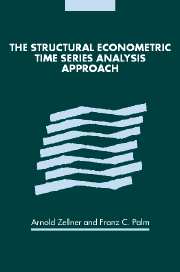Book contents
- Frontmatter
- Contents
- List of contributors
- Acknowledgments
- Introduction
- Part I The SEMTSA approach
- Part II Selected applications
- 6 Time series and structural analysis of monetary models of the US economy (1975)
- 7 Time series versus structural models: a case study of Canadian manufacturing inventory behavior (1975)
- 8 Time series analysis of the German hyperinflation (1978)
- 9 A time series analysis of seasonality in econometric models (1978)
- 10 The behavior of speculative prices and the consistency of economic models (1985)
- 11 A comparison of the stochastic processes of structural and time series exchange rate models (1987)
- 12 Encompassing univariate models in multivariate time series: a case study (1994)
- Part III Macroeconomic forecasting and modeling
- Part IV Disaggregation, forecasting, and modeling
- Subject index
- Author index
- References
12 - Encompassing univariate models in multivariate time series: a case study (1994)
Published online by Cambridge University Press: 24 October 2009
- Frontmatter
- Contents
- List of contributors
- Acknowledgments
- Introduction
- Part I The SEMTSA approach
- Part II Selected applications
- 6 Time series and structural analysis of monetary models of the US economy (1975)
- 7 Time series versus structural models: a case study of Canadian manufacturing inventory behavior (1975)
- 8 Time series analysis of the German hyperinflation (1978)
- 9 A time series analysis of seasonality in econometric models (1978)
- 10 The behavior of speculative prices and the consistency of economic models (1985)
- 11 A comparison of the stochastic processes of structural and time series exchange rate models (1987)
- 12 Encompassing univariate models in multivariate time series: a case study (1994)
- Part III Macroeconomic forecasting and modeling
- Part IV Disaggregation, forecasting, and modeling
- Subject index
- Author index
- References
Summary
Through the encompassing principle, univariate ARIMA analysis could provide an important tool for diagnosis of VAR models. The univariate ARIMA models implied by the VAR should explain the results from univariate analysis. This comparison is seldom performed, possibly due to the paradox that, while the implied ARIMA models typically contain a very large number of parameters, univariate analysis yields highly parsimonious models. Using a VAR application to six French macroeconomic variables, it is seen how the encompassing check is straightforward to perform, and surprisingly accurate.
Introduction
After the crisis of traditional structural econometric models, a particular multivariate time series specification, the Vector Autoregression or VAR model has become a standard tool used in testing macroeconomic hypotheses. Zellner and Palm (1974, 1975) showed that the reduced form of a dynamic structural econometric model has a multivariate time series model expression, and that this relationship could be exploited empirically as a diagnostic tool in assessing the appropriateness of a structural model. As Hendry and Mizon (1992) state, a well-specified structural model should encompass the results obtained with a VAR model; similar analyses are also found in Monfort and Rabemananjara (1990), Clements and Mizon (1991), and Palm (1986).
It is also well known that a multivariate time series model implies a set of univariate models for each of the series. Thus, as argued by Palm (1986), univariate results can, in turn, provide a benchmark for multivariate models, and should be explained by them.
- Type
- Chapter
- Information
- The Structural Econometric Time Series Analysis Approach , pp. 418 - 454Publisher: Cambridge University PressPrint publication year: 2004

